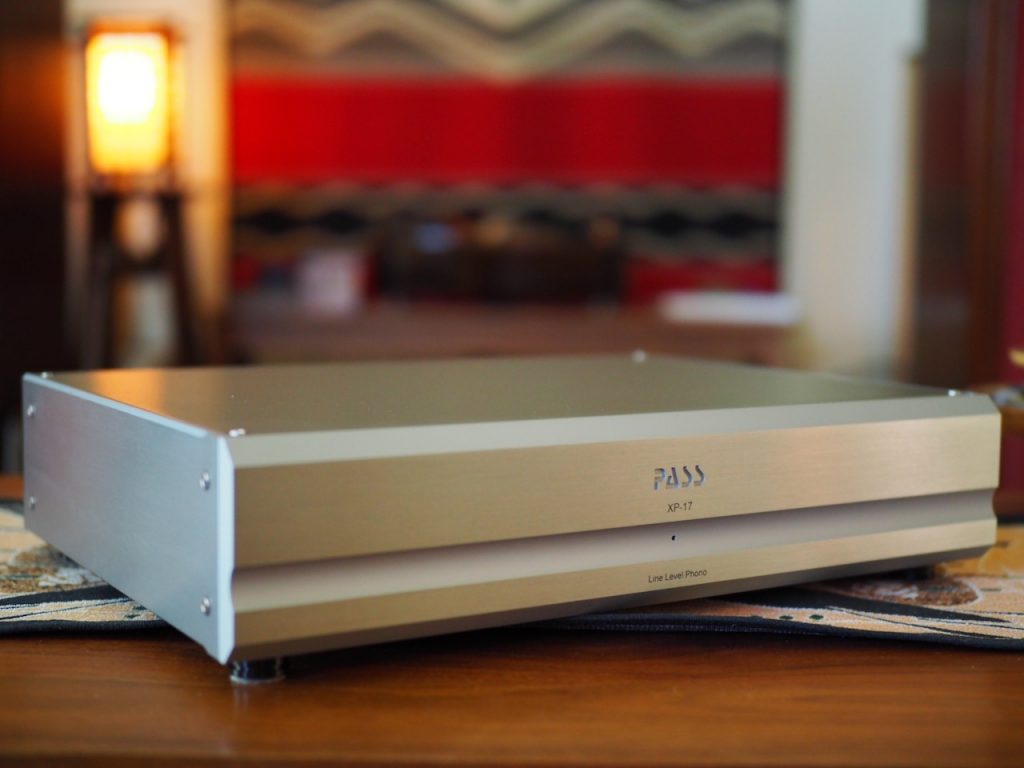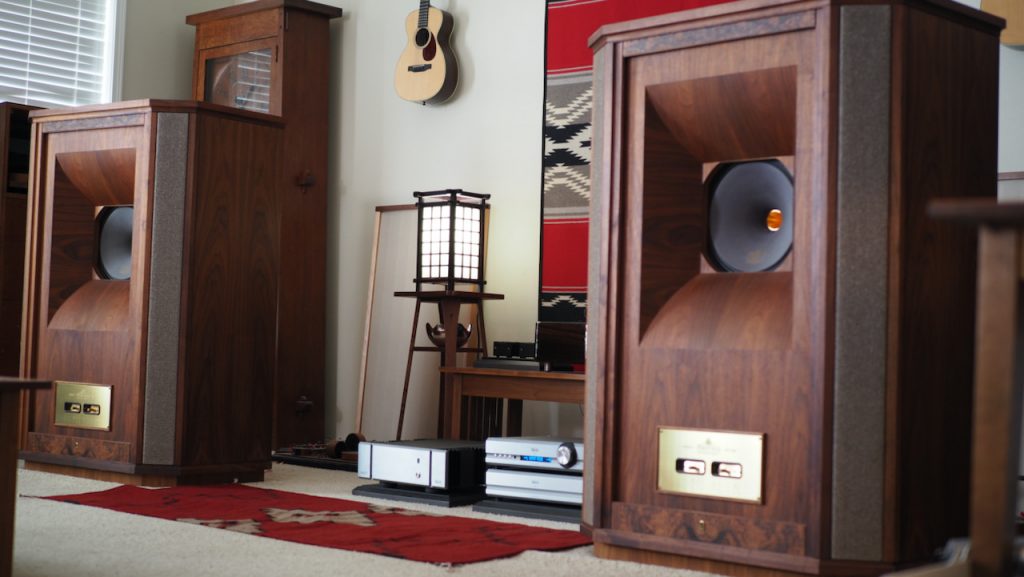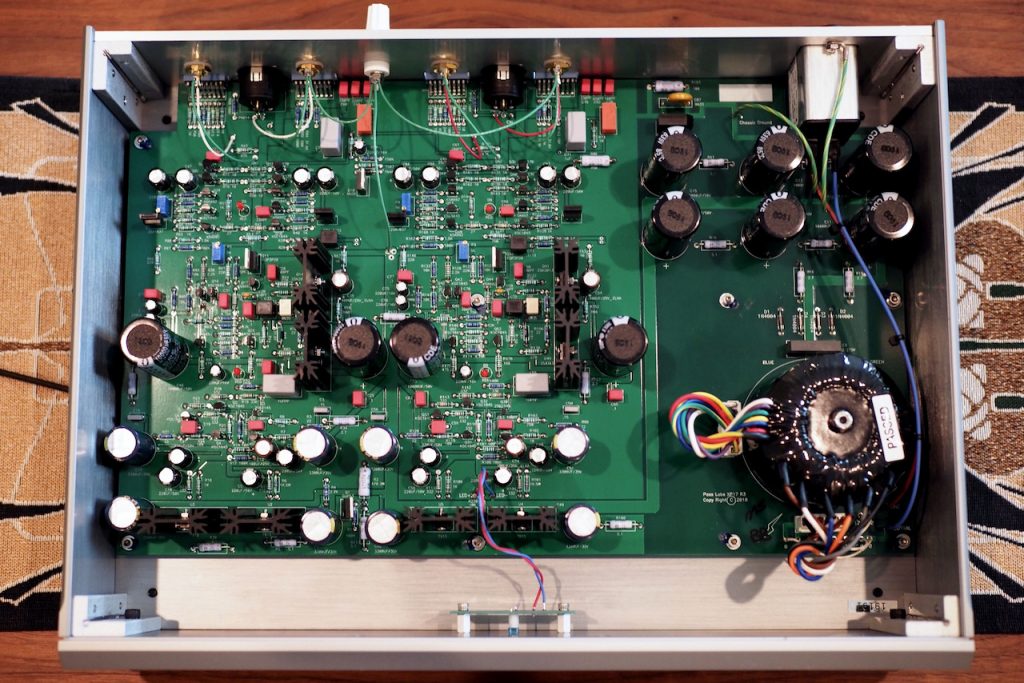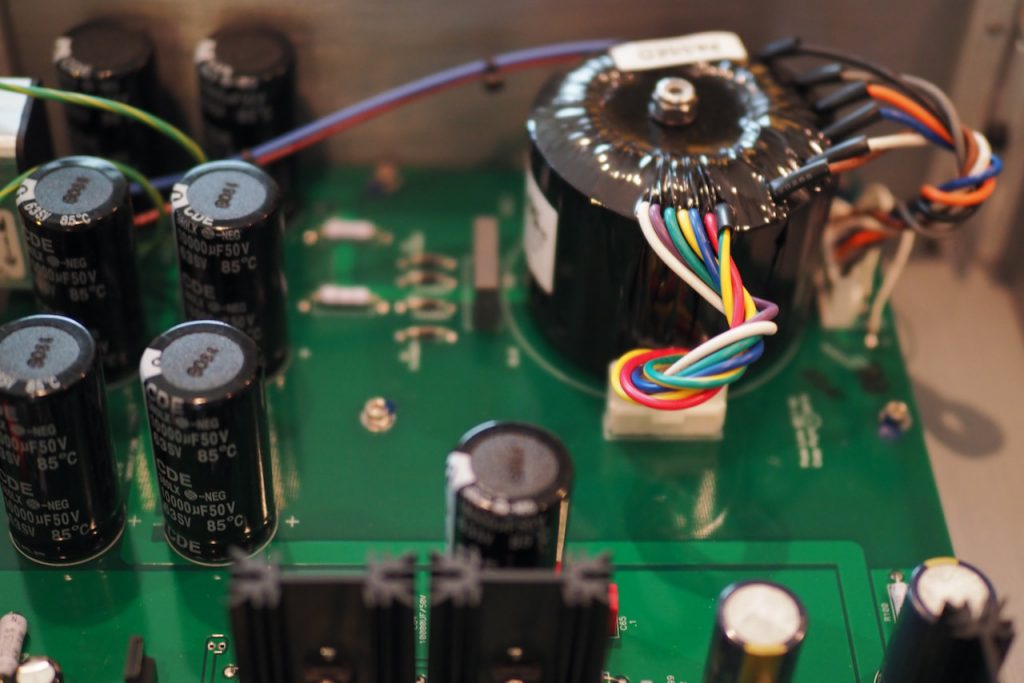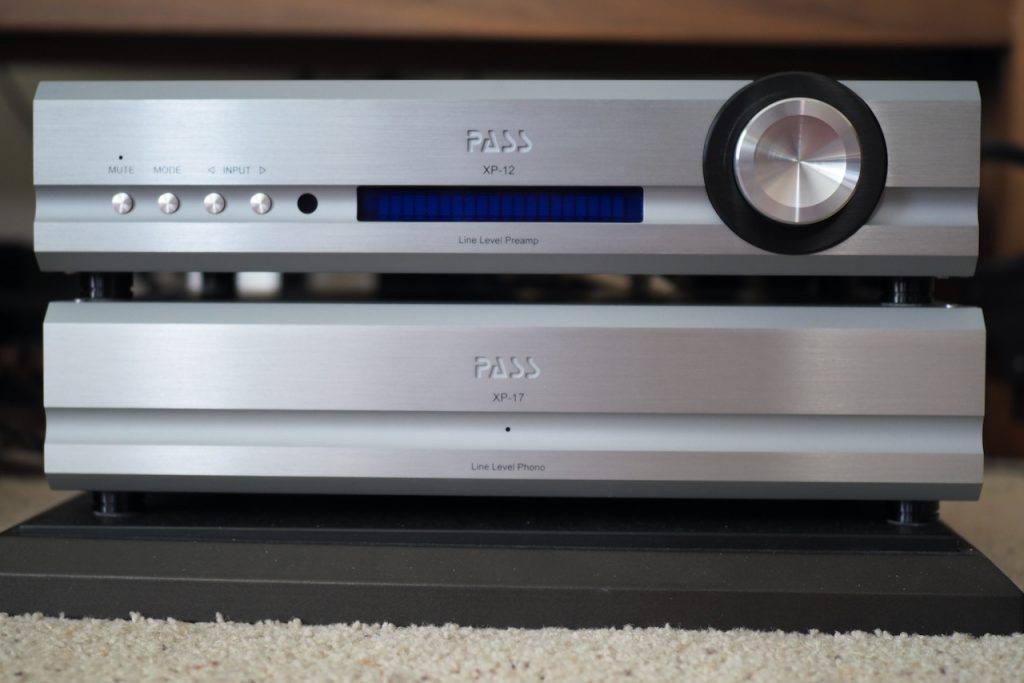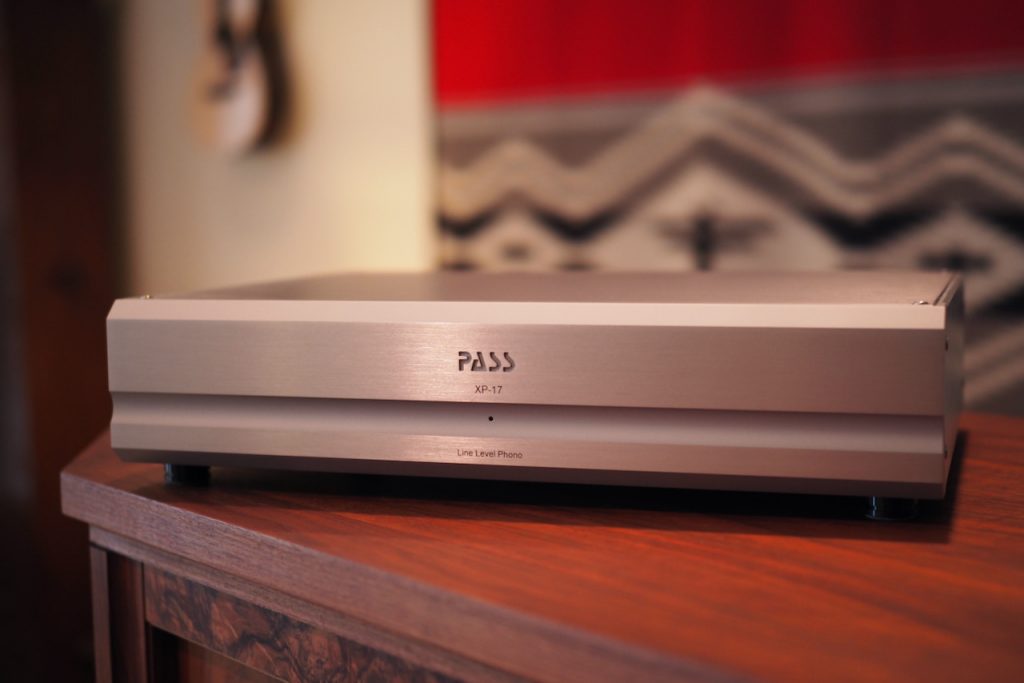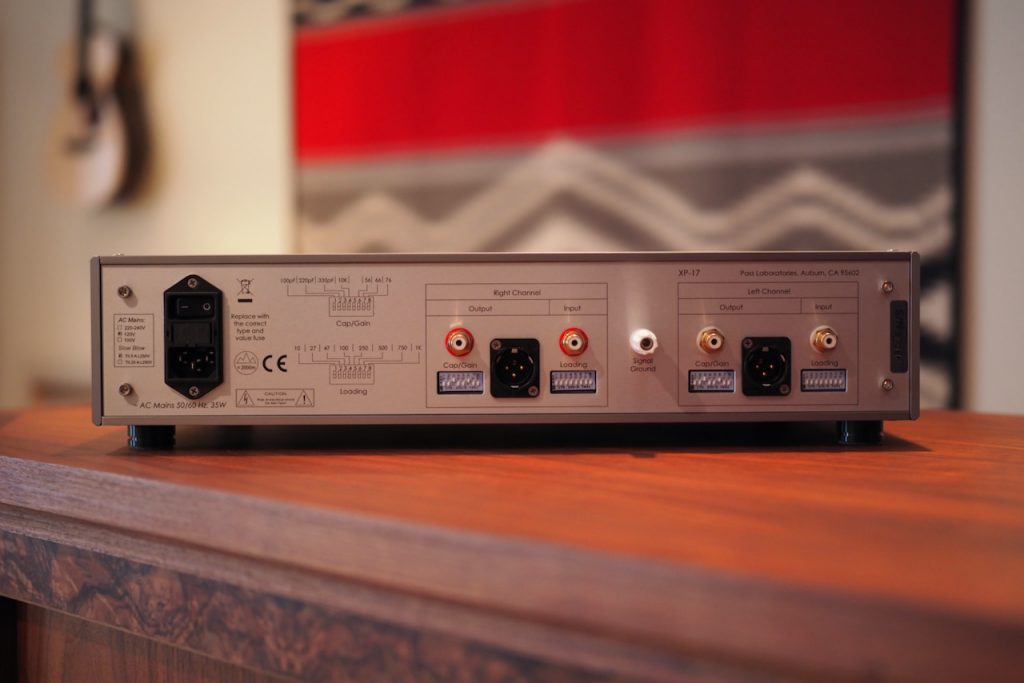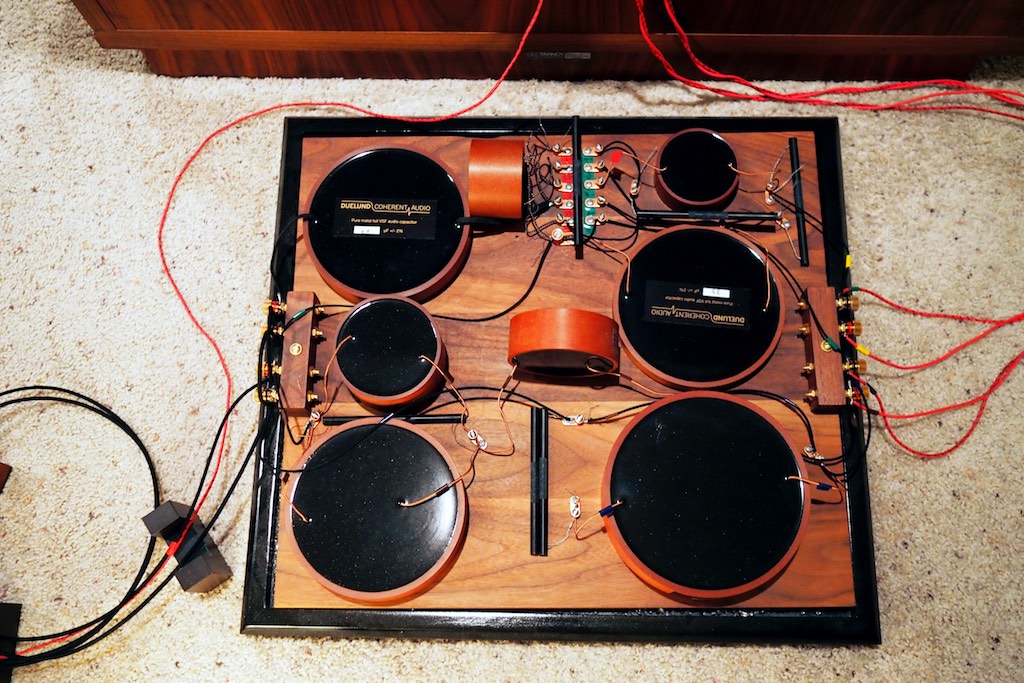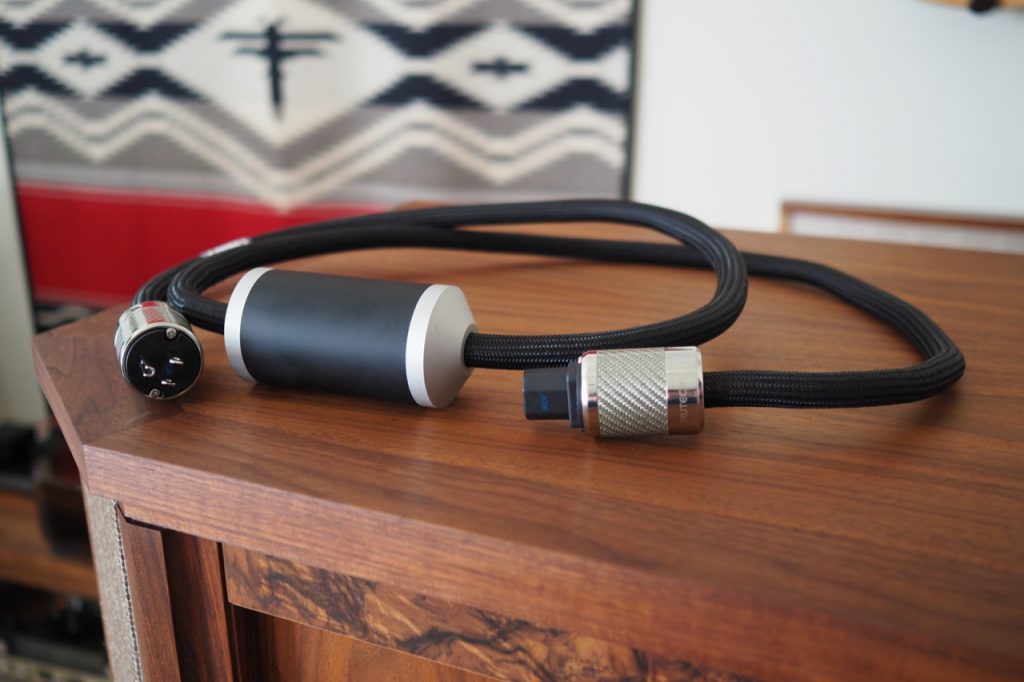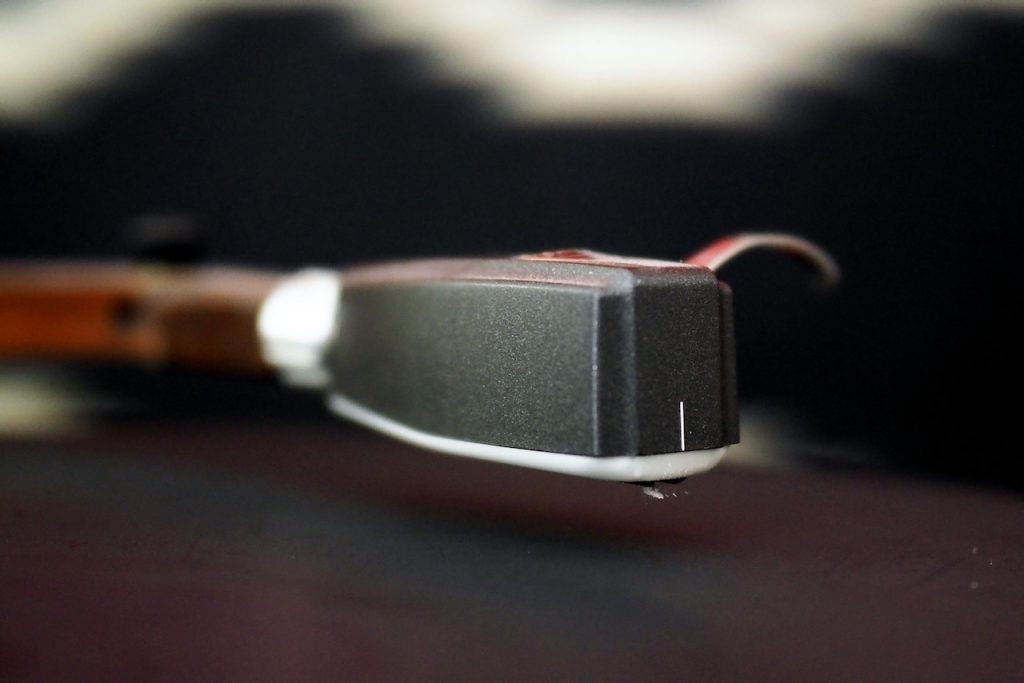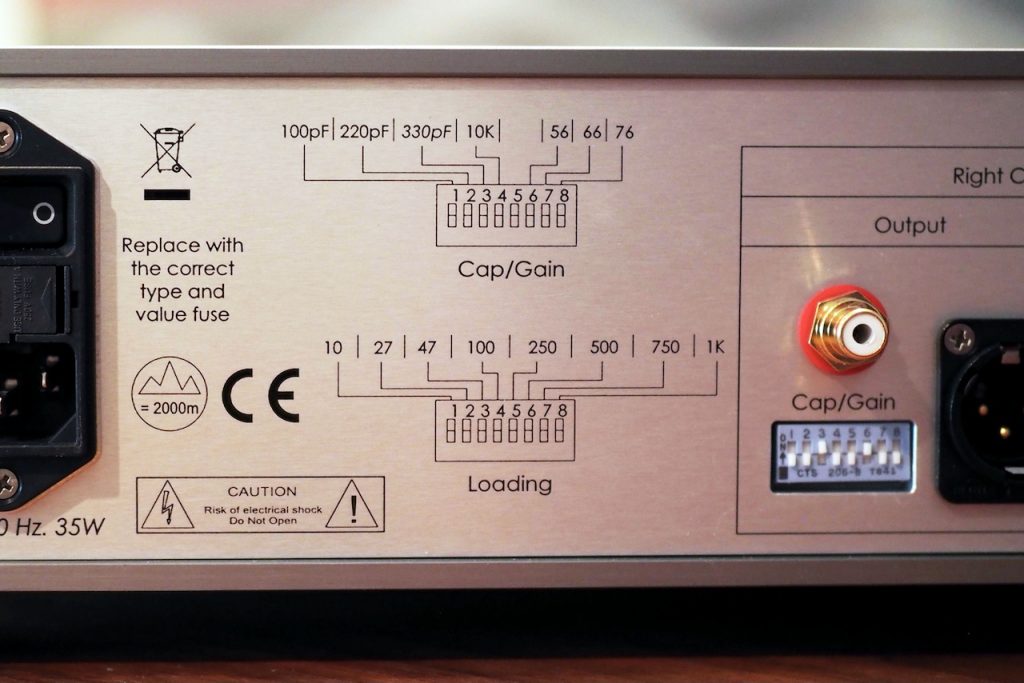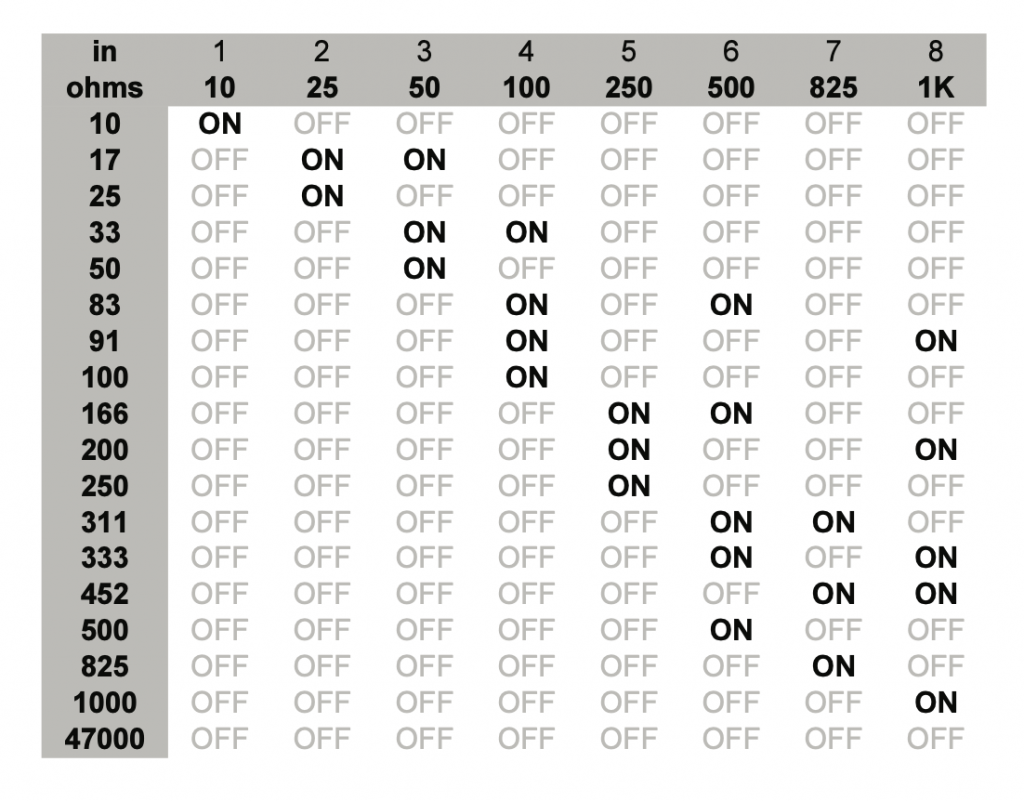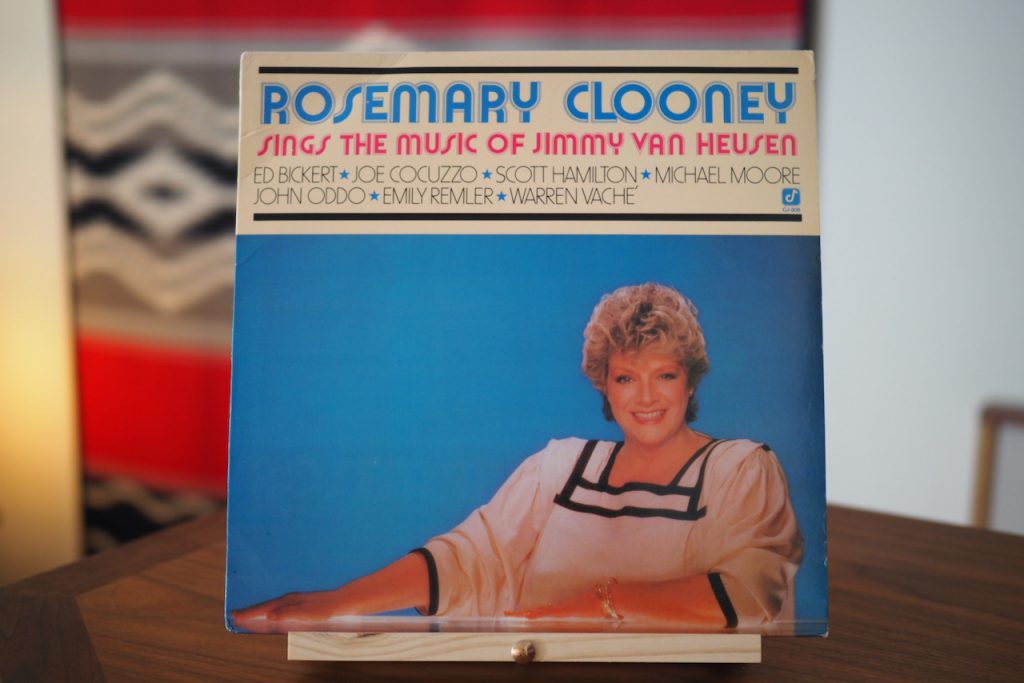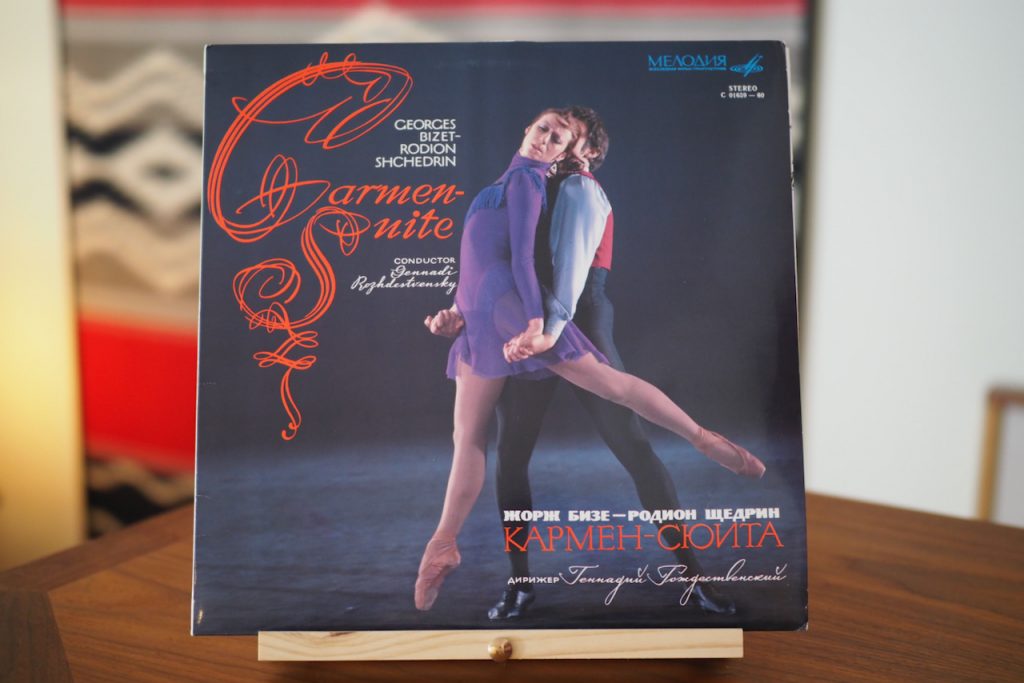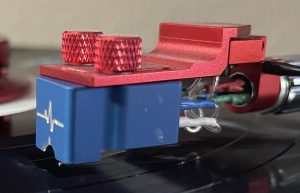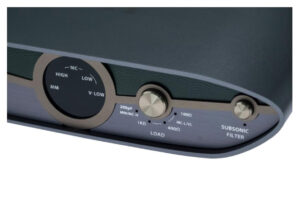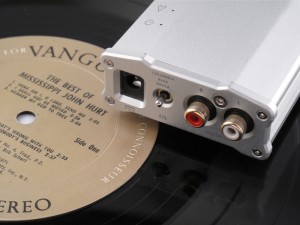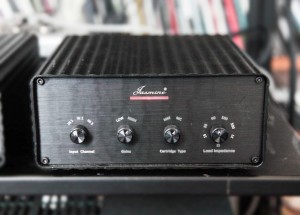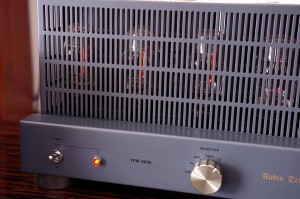I was really impressed by the Pass Labs XP-12 line-level preamplifier that I wrote about in Positive Feedback Issue 111 (HERE), and I have been looking forward to telling you about my time with its intended phono preamplifier partner, the Pass Labs XP-17.
Given that Nelson Pass and Wayne Colburn both use Tannoy 15-inch dual concentric drivers in custom cabinets as part of the voicing and evaluation process for their audio component designs, I thought I would focus my listening impressions for the Pass Labs XP-17 phono preamplifier on listening sessions with my Tannoy Westminster Royal Special Edition loudspeakers that also use Tannoy 15-inch dual concentric drivers (HERE), to provide a similar context to that used by Nelson and Wayne.
I've been impressed with Pass Labs XP-17 phono preamplifier's sound quality and musicality, its excellent build quality, its non-fussy demeanor in interfacing with various audio system equipment combinations I've tried, and its very useful adjustability features that allowed me to get excellent performance out of the moving-coil, moving-iron, and moving-magnet phonograph cartridges I explored for this article.
The Pass Labs XP-17 Phono Preamplifier ($4300 USD)
I hope you had a chance to read my article about the Pass Labs XP-12 line-level preamplifier in Positive Feedback Issue 111, but if not, please allow me to repeat myself just a little bit, and tell you about Pass Labs audio designer Wayne Colburn, who was responsible for the design of both the XP-12 line-level preamplifier, and the XP-17 phono preamplifier discussed in this article.
Wayne Colburn and Nelson Pass have been working together designing audio electronics for over 35 years, are good friends, and Wayne is one of the four business partners of Pass Labs.
Photograph by David W. Robinson, copyright (c) 2018, all rights reserved.
When Nelson told me about the history of Wayne's design work, he said, "… Wayne has largely concentrated on preamplifiers. You might think of analog electronics as a "solved problem," and that given the current state of the art there is little improvement to be had in this field, and yet Wayne continually revisits previous designs and teases a bit more out of them—often with a newer, better, component, or a subtle refinement of topology, and occasionally with something more radical. These pieces all have excellent measurements before they are evaluated subjectively in long term extensive listening tests, a process that can last many months.
"Wayne's is a history of product design of over three decades, which has produced classic pieces, each enjoying a long lifespan, and eventually giving way to successor products which incrementally improves the products, reaffirming the promise of the original."
Wayne has designed an incredible number of audio electronics while working with Nelson, including the Forte 44, the Threshold T2, the Pass Labs Aleph P preamplifier and Aleph P remote, the Adcom GFP 750 preamplifier, the Pass Labs X0 preamplifier, the Pass Labs X1 preamplifier, the Pass Labs X2.2 preamplifier, the Pass Labs X2.5 preamplifier, the Pass Labs X0.2 preamplifier, the Pass Labs D1 DAC, the Pass Labs Aleph Ono Phono, the Pass Labs X Ono Phono, the Pass Labs XP25 Phono, the Pass Labs XS preamplifier, the Pass Labs XS phono preamplifier, the Pass Labs XP15 phono preamplifier, the Pass Labs XP17 phono preamplifier, the Pass Labs XP27 phono preamplifier, the Pass Labs XP10 preamplifier, the Pass Labs XP20 preamplifier, the Pass Labs XP30 preamplifier, the Pass Labs XP12 preamplifier, the Pass Labs XP22 preamplifier, XP32 preamplifier, the entire Pass Labs integrated amplifier line, as well as the Pearl phono preamplifier, the Pearl 2 phono preamplifier, the Burning Amp 2017 WHAMMY headphone amplifier, and the Burning Amp 2018 line-stage, for the DIY community.
Wayne's got an impressive audio equipment design résumé!
It turns out that the Pass Labs XP-17 phono preamplifier is one of those designs mentioned by Nelson that resulted from Wayne revisiting a predecessor design, the Pass Labs XP-15 phono preamplifier, and updating it with design concepts used in the much more expensive Pass Labs XP-25 and XS Phono phono preamplifiers, as well as a number of other design insights gleaned along the way.
To quote from the Pass Labs website about the XP-17:
"[The] XP-17 uses the new-shielded low noise toroid and input filter module, like the XP-12. The power supply has an extra stage of RC filtering. We have lower radiated and mechanical noise.
"The XP-17 has an all-new input circuit that is symmetrical and lower in noise and distortion with greater drive capability. Noise is the most prominent part of THD+N in the first section of a phono stage. By lowering noise we get better resolution and dynamics.
"Designed with a split EQ network like the XP-25 and XS Phono that is more accurate and can handle greater signal levels.
"The secondary stage runs a higher bias output stage with auto bias.
"The numerous loading options from the XP-15 are all still available, and three gain settings to accommodate low output MC to MM cartridges."
Let's do a walk-around of the XP-17 phono preamplifier and explore its features.
As you can see in the accompanying photos, the front of the XP-17 has the same chassis styling as the XP-12 line-preamplifier, with the front panel having a small blue indicator light to show the XP-17 is powered up, while the engraved "Pass" identifies the brand, and the "XP-17 Line Level Phono" identifies the model.
Around back, starting from the left side, you can see the IEC mains inlet (bottom), fuse holder (middle), and power switch (top).
To the right of the mains you can see the diagrams that show how the cartridge resistive loading DIP (dual in-line package) switches function (bottom), how the cartridge capacitive loading DIP switches function (top left), and the available gain setting DIP switches (top right).
As we continue to the right we see the right channel RCA/balanced input/output and loading/gain switches.
Next we see the signal ground for the tonearm, and to the right of the signal ground we see the left channel RCA/balanced inputs/outputs and loading/gain switches.
That's it—a nice clean and functional layout.
Associated Equipment
For this article I used my Tannoy Westminster Royal Special Edition loudspeakers that have been modified with external crossovers, built using a combination of silver and copper Duelund CAST components during the Duelund-Westminster Project of 2013 (HERE).
To get a feel for the voicing of the Pass Labs XP-17 phono preamplifier—partnered with its matching Pass Labs XP-12 line-level preamplifier—I listened to the XP-17 with the Pass Labs XA25 stereo amplifier—that I wrote about in Positive Feedback Issue 106 (HERE)—that serves as my solid-state amplifier reference, along with the First Watt SIT-3 single-ended stereo amplifier that I wrote about in Positive Feedback Issue 98 (HERE).
I used Duelund DCA16GA tinned-copper speaker cables to connect the Westminsters to the Pass Labs XA25 stereo power amplifier, Belden 8402 tinned-copper microphone cable interconnects to connect the XA25 to the Pass Labs XP-12 preamplifier, and shielded Duelund DCA16GA tinned-copper interconnects to connect the Pass Labs XP-12 preamplifier to the Pass Labs XP-17 phono preamplifier.
The power cords I used for the Pass Labs XA25 stereo amplifier, XP-12 preamplifier, and XP-17 phono preamplifier were all by Acoustic Revive (a combination of Power Reference, Power Reference TripleC NCF, and Absolute power cords).
My CTC Garrard 301 turntable served as the source, using either a Woody or Schick tonearm, with a selection of moving-coil, moving-iron, and moving-magnet phonograph cartridges.
Optimizing the Performance of the Pass Labs XP-17 Phono Preamplifier
I've found the Pass Labs XP-17 phono preamplifier to have impressive sound quality and musicality in my listening sessions, and one enabler of that sound quality is the ability to optimize the XP-17's performance for any given category or brand/model of phonograph cartridge.
Moving-magnet, moving-coil, and moving-iron phonograph cartridges all have very different requirements for gain, resistive loading, and capacitive loading, and within those phonograph cartridge categories, each brand and model have different output voltages, internal resistance, and recommended loading impedance that must be satisfied to hear those phonograph cartridges at their intended best.
Most phono preamplifiers don't have the ability to adjust those parameters to optimize them for the particular needs of specific phonograph cartridges, due to their gain, resistive loading, and capacitive loading all being fixed values, which means the resulting performance of your cartridge can be somewhat of a hit or miss affair, and the result may not be representative of what that cartridge's performance is truly capable of.
I thought I would walk you through examples of moving-coil cartridges (Ortofon SPU Classic G MkII, and Audio Note (UK) Io I), a moving-iron cartridge (Soundsmith Zephyr MkIII), and a moving-magnet cartridge (Clearaudio Virtuoso Wood), optimizing the performance of XP-17 for each of their requirements in terms of gain, resistive loading, and capacitive loading, according to the guidance provided in the Pass Labs XP-17 owner's manual, to give you a feel for how that works, and the performance results it yields.
Optimizing the Pass Labs XP-17 for the Ortofon SPU Classic G MkII Moving-Coil Phonograph Cartridge ($1082 USD)
One often finds moving-coil cartridges in high-performance audio systems, so I thought I would start with a couple of examples of optimizing the XP-17's settings for moving-coil cartridges.
My Ortofon SPU Classic G MkII moving-coil phonograph cartridge's design origins go all the way back to 1959. Ortofon's enduring SPU offerings still enjoy great popularity today, over 60 years after their introduction, and make for a nice example of optimizing the XP-17's gain, resistive loading, and capacitive loading for a classic stereo pick-up (SPU) moving-coil phonograph cartridge.
There are a few moving-coil cartridges that have an output of a couple of millivolts, but more typically moving-coil cartridges have a signal output in the tenths to hundredths of a millivolt range, so you'll want to check the specifications for your particular cartridge before setting the gain.
If you look at the upper of the two diagrams on the back of the XP-17, you'll see that the "Cap/Gain" DIP switches 6, 7, and 8 for each channel provide 56, 66, and 76 dB of gain, respectively, when using balanced interconnects. With the RCA interconnects I used, that's reduced to 50, 60, and 70 dB of gain.
For moving-coil cartridges with a couple of millivolts of output you'll want to start with 56 dB of gain ("Cap/Gain" switch 6 to "on"), and for moving-coil cartridges with tenths or hundredths of a mV output, you'll want one of the higher gain options of 66 dB or 76 dB to achieve adequate volume levels (DIP "Cap/Gain" switches 7 or 8 to "on").
Note: Whenever I refer to setting any of the XP-17's switches to "on," I am referring to settings for both the right and left channels, which must be set identically for the XP-17 to operate correctly.
For example, with my Ortofon SPU Classic G MkII's 0.2 mV of output, I started by setting the XP-17 to 66 dB (DIP "Cap/Gain" switch 7 to "on"), but that didn't provide enough gain, so I set the XP-17 to 76 dB of gain (DIP "Cap/Gain" switch 8 to "on"), which provided adequate gain for live-like volume levels.
The appropriate resistive loading for a given moving-coil phonograph cartridge can vary quite a bit depending on the cartridge's internal impedance. Moving-coil cartridges have internal impedances that typically range from a low 1 Ohm all the way up to around 130 Ohms.
A rule of thumb for setting resistive loading for a moving-coil cartridge is to start with a resistive loading that is five to ten times the internal impedance of the cartridge, and then try a number of variations until you find an optimum overall spectral balance, and the most dynamic presentation, for your cartridge and personal tastes.
With that rule of thumb in mind for phonograph cartridge internal impedances of 1 Ohm to 130 Ohms, that means you may want to use resistive loading settings on the XP-17 that vary from around 5 Ohms, all the way up to around 1000 Ohms, for any given moving-coil cartridge.
In the table above, you can see some of the possible XP-17 resistive loading switch setting combinations, and the overall resistive loading they provide in the left-most column.
The Ortofon website doesn't say much on the topic of resistive loading, only that they recommend a resistive loading of greater than 10 Ohms for the 2 Ohms internal impedance of the Ortofon SPU Classic G MkII, and that "The sound character is influenced by the input/load impedance. The lower the load impedance, the higher the current and the more dynamic the sound will be."
The Ortofon SPU Classic G MkII has an internal impedance of 2 Ohms, so the rule of thumb for resistive loading would be to set the "Loading" DIP switches to a range of about 10 to 20 Ohms.
To give you a better idea of what's going on when optimizing resistive loading, let me expand a little on how the overall sound character can be influenced by resistive loading, which alters the frequency response of moving-coil phonograph cartridges above approximately 1000Hz.
First, let's take a hypothetical "typical" moving-coil cartridge example, where decreasing levels of resistive loading decreases output of the cartridge nonlinearly with increasing frequency from about 1000Hz to 10,000Hz.
Generally speaking, from 1000Hz to 10,000Hz, less resistive loading reduces output across that band, and more resistive loading increases output across that band.
In frequencies from 10,000Hz to 20,000Hz output rises quickly with increasing resistive loading, and drops just as quickly with less resistive loading.
I was reading through a discussion of recording studio techniques recently, which broke down the audio spectrum into seven frequency bands, and how the perception of the overall sound can be altered by adjusting the equalization for each of those frequency bands.
I thought the discussion provided some nice examples of how changing equalization in the frequency bands affects overall sound quality, and was somewhat analogous to what I heard when changing moving-coil cartridge response with different resistive loading settings.
The frequency bands discussed were the sub-bass (20-60Hz), the bass (60-250Hz), the lower midrange (250-500Hz), the midrange (500-2000Hz), the upper midrange (2000-4000Hz), the presence region (4000-6000Hz), and the brilliance region (6000 to 20,000Hz).
With moving-coil cartridges, resistive loading changes output levels above approximately 1000Hz, so I have only included commentary as to what one might hear in those regions.
Boosting the midrange (500-2000Hz) can make some instruments sound more prominent, but can also alter the timbre of the human voice, with too much boost in the midrange making the sound fatiguing to listen to.
Altering the upper midrange (2000-4000Hz) alters the timbre of instruments and vocals. This is also the region where the attack of percussion and rhythm instruments occurs, so boosting it can add presence, but boosting it too much can cause listening fatigue.
The presence region (4000-6000Hz) is responsible for the sense of overall resolution and clarity of the sound. Boosting this region too much can cause the sound to become harsh and irritating, and cutting it too much can cause the sound to become more distant and less resolved.
The brilliance region (6000 to 20,000Hz) is where the harmonics, sparkle, and "air" of the recording resides. Boosting around 12,000Hz gives a "hifi spectacular" sort of presentation, with too much boost accentuating noise and tape hiss which can cause increased listening fatigue.
The take-away message of all that is that the amount of resistive loading of moving-coil cartridges affects those regions above 1000Hz for better or worse, which is why cartridge manufacturers specify internal impedance and the amount of resistive loading that makes their moving-coil cartridge perform in optimum fashion.
Now, let's go ahead and look at the resistive loading settings of the XP-17, and how that affects cartridge performance while listening to albums.
Here's how the XP-17's switch settings work: The XP-17 has a fixed input value of 47k Ohms, and user selectable values of 10 (switch 1), 27 (switch 2), 47 (switch 3), 100 (switch 4), 250 (switch 5), 500 (switch 6), 750 (switch 7), and 1K Ohms (switch 8), that when turned to the "on" position places those values in parallel with the 47k Ohm fixed input value.
If you don't have the parallel resistance equation memorized, you can use one of the online parallel resistance calculators to figure out the overall resistive loading for a given set of DIP switches when placed in parallel with the fixed input value of 47k Ohms, like the one HERE at Digi-Key.
I chose to try resistive loading settings from 5.66 Ohms to 980 Ohms, by utilizing combinations of the resistive loading switches, to get a feel for how various resistive loading settings affected my SPU cartridge.
Over the history of the recording arts that there have been a vast number of recordings that feature important musical performances, with only a few of those important musical performances - perhaps less than 1%—being recorded in what contemporary audiophiles would consider to be high-fidelity recordings.
With all that in mind, I chose a few records of music that spanned the range from poor-ish to good recording quality, with the goal of finding a resistive loading setting that made the 99% of normal recordings as musically satisfying as possible, while still getting excellent performance from the 1% of exemplary recordings that are typically talked about in audiophile circles.
What I didn't want was a resistive loading setting that got the best out of recordings favored by audiophiles, but would make everything of normal or lesser recording quality unpleasant to listen to, which is a common issue with audio systems voiced using only the 1% of exemplary recordings.
I wanted to find a resistive loading setting that provided the best overall tonal balance and the most dynamic presentation over a range of recording quality, in order to make as many of the albums in my collection enjoyable listening experiences as possible.
Sometimes hifi gear marketed to audiophiles subtly boosts the presence region (4000-6000Hz) and brilliance region (6000 to 20,000Hz) in order to give listeners a sense of greater overall resolution and clarity, and to provide a "hifi spectacular" sort of presentation. It gets audiophiles attention on the showroom floor, but when this boost is overdone, over the long term it creates the number one issue I hear about from audio enthusiasts, which is that their system accentuates noise, sounds harsh, irritating, fatiguing, and isn't very fun to listen to most music with. Now you know.
The beauty of the Pass Labs XP-17 phono equalizer is that it allows the listener to optimize cartridge performance to achieve a natural tonal balance across the audio spectrum so that boost issue in the presence and brilliance regions becomes a non-issue, or is at least minimized to acceptable levels.
As an example, to get started, I used three LPs to aid me in determining an overall resistive loading setting for my SPU:
Rosemary Clooney Sings The Music Of Jimmy Van Heusen, featuring Rosemary Clooney (vocals), Ed Bickert (guitar), Joe Cocuzzo (drums), Scott Hamilton (tenor sax), Michael Moore (bass), John Oddo (piano), Emily Remler (guitar), and Warren Vaché Jr. (cornet). Concord Records CJ-308.
Outstanding Violinists of the Past, Myron Polyakin, Sonata No. 9 For Violin and Piano, La Major, Sooch. 47 Kreutzerova. Melodiya.
Georges Bizet - Rodion Shchedrin, Carmen Suite, Gennadi Rozhdestvensky, Conductor, the USSR Bolshoi Theatre Orchestra. Melodiya C 01659-60.
The Rosemary Clooney album has the typical overall recording quality of a popular recording, with a few oddities. Most importantly to me, there are a couple of duets—"The Second Time Around" and "Call Me Irresponsible"—with Rosemary Clooney and one of my all-time favorite jazz guitarists, Ed Bickert. How much do I appreciate Ed Bickert's jazz guitar playing? Enough so that I built a near-replica of Ed's legendary modified Fender Telecaster to use for my own jazz guitar studies.
Natural violin tone can be a challenge for a fair number of hi-fi components, and on top of that the Polyakin album has some sound quality recording issues, and it is kind of noisy. However, the musical performances of the legendary Russian violinist Miron Polyakin from long ago (1894 to 1941) are transcendent, making this an indispensable album of musical performances that are beyond reproach.
If an audio system—or a phonograph cartridge—can't provide natural tone, and transcend recording quality issues to make an album of Polyakin's music accessible musically, for example, and be enjoyable to listen to, then for me that system or phonograph cartridge would be too limiting musically, and would not be worth owning, as it would inhibit listening to much of our recorded music canon that was recorded at lower or average fidelity.
The Bolshoi Theatre Orchestra album features both excellent recording quality and musical performances that are superb, providing the upper recording quality range for these three example albums.
With a resistive loading setting with a fixed input value of 47k Ohms, and the DIP switches for 10 Ohms (switch 1), 27 Ohms (switch 2), 47 Ohms (switch 3), 100 Ohms (switch 4), 250 Ohms (switch 5), 500 Ohms (switch 6), 750 Ohms (switch 7), and 1000 Ohms (switch 8), were all turned to the "on" position, the overall parallel resistive loading value was approximately 5.66 Ohms.
5.66 Ohms of resistive loading is below what Ortofon recommends, but my SPU sounded nicely musical at 5.66 Ohms, albeit to the rich and lush side of neutral, with a reasonably well-balanced and natural presentation of low-end, midrange, but with higher-frequencies being somewhat down in level.
At 5.66 Ohms of resistive loading, Rosemary's voice was gorgeous, Ed Bickert's guitar playing was amazingly live-like, horns sounded like they do in an intimate jazz club setting, and the whole experience of listening to the album was one of emotional involvement and a sense of awe at the prodigious talents of the musicians.
5.66 Ohms of resistive loading also flattered the less than wonderful recording quality of the Polyakin album by minimizing noise by reducing output in the presence and brilliance regions, and maximizing Polyakin's gorgeous tone and remarkable virtuosity through the midrange.
The Georges Bizet - Rodion Shchedrin, Carmen Suite, conducted by Gennadi Rozhdestvensky, was an excellent musical performance blessed by excellent recording quality, and 5.66 Ohms of resistive loading provided an overall sound quality and musicality that was breathtaking, albeit somewhat romanticized by reduced output in the presence and brilliance regions.
With a resistive loading setting with a fixed input value of 47k Ohms, and the 27 Ohms (switch 2) and 47 Ohms (switch 3) DIP switches were turned to "on", the overall parallel resistive loading value was 17.1 Ohms, about in the middle of the 10 to 20 Ohms rule of thumb range that one would expect to be optimum for the SPU.
The SPU sounded nicely musical at the 17.1 Ohm setting, with a well-balanced and natural presentation of low-end, midrange, and with modestly reduced high-frequencies. At the 17.1 Ohm setting my SPU cartridge provided an overall presentation that wasn't as rich and lush as the 5.66 Ohms setting, but was still a touch to the rich and lush side of neutral, and very musically engaging.
With the fixed input value of 47k Ohms, when the 27 Ohms (switch 2) and 100 Ohms (switch 4) were turned to "on," the resistive loading value was 21.3 Ohms, slightly above the rule of thumb resistive loading range, and as with the 17.1 Ohms setting, my SPU sounded well-balanced and natural in the low-end, midrange, and high-frequencies, but was more neutral than at the lower Ohm settings.
With my SPU cartridge, lower Ohm resistive loading settings—like 5.66 Ohms, 17.1 Ohms, or 21.3 Ohms—sounded more musically natural, had better overall tone, and had less upper-midrange and high-frequency energy, which tended to minimize recording issues and noise to make a larger range of recording quality more enjoyable to listen to.
When I tried higher Ohm resistive load settings, say from several hundred Ohms up to 980 Ohms (the 1000 Ohm setting of switch 8 in parallel with the fixed value of 47K Ohms), for example, my SPU sounded more forward, somewhat harder, had more upper-midrange and high-frequency energy that accentuated noise and other recording issues, and in the case of female vocals, also resulted in more noticeable sibilance.
My ability to enjoy the musical performances suffered at higher Ohms settings, as issues with recording quality became more pronounced and unpleasant, which limited the range of recordings that I could listen to enjoyably.
I didn't hear a large difference in dynamics at lower resistive loading settings with my SPU, as the Ortofon web site hinted might be the case, but rather what I heard as the major resistive loading effect was how much upper-midrange and high-frequency energy was presented by the cartridge, and how that affected the overall presentation of the music.
The next step after setting the resistive loading was to set the capacitive loading.
Here's how the capacitive loading works: There are three capacitive loading switches with values of 100pF (switch 1), 220pF (switch 2), and 320 pF (switch 3). If you turn one or more of those switches to the "on" position, it adds that value of capacitance to the fixed 100pF default value, giving a range of 100pF (no switches turned to "on") to 750pF (all three switches set to "on").
I started with the resistive loading set to 21.3 Ohms and the default 100pF fixed value for capacitive loading, and listened to the Lucinda Williams album World Without Tears, an album of music that I enjoy, but the recorded sound quality has always struck me as a bit forward, hard, and edgy overall.
I can't tell you how many times I've listened to this album over the years with my SPU, but I can tell you that before trying the Pass Labs XP-17 phono preamplifier, I've never heard Lucinda sound as good as with the resistive loading set to 21.3 Ohms, and the capacitive loading set at the default of 100pF.
Well, that was until I tried adding 100pF of capacitive loading by turning on the "100pF" capacitive switch, for a total of 200pF, which I thought subtly improved the sound quality.
The magnitude of change of adding capacitive loading wasn't nearly as great on my SPU's performance as adding resistive loading. Differences in capacitive loading were subtle but noticeable.
With a capacitive loading of 320pF, I felt that degraded the sound quality subtly, so I went back to a total of 200pF.
Out of curiosity, I went back to 5.66 Ohms of resistive loading, with the 200pF of capacitive loading, and that combination provided the best overall tonal balance for World Without Tears, and minimized the effects of the album's recording issues.
What I learned from experimenting with the resistive and capacitive loading settings of the Pass Labs XP-17 phono preamplifier, was that I've never heard my Ortofon SPU Classic G MkII moving-coil phonograph cartridge display as good of sound quality and musicality as it did with its performance optimized by the XP-17.
Finding the optimum resistive loading settings made a big difference in my Ortofon SPU Classic G MkII's performance, and significantly increased my enjoyment of the music, and the span of recording quality I could listen to enjoyably.
Capacitive loading didn't make a big difference with my SPU, its contribution was more subtle.
Given that there is a fairly large variation in sound quality from album to album, if one wanted to, one could catalog resistive and capacitive loading settings for each album, instead of using values averaged across a variety of albums. That's even a little too anal for me, but given it is only the flip of a few switches, for the truly obsessed among us that approach could provide much joy.
Optimizing the Pass Labs XP-17 for the Audio Note (UK) Io I Moving-Coil Phonograph Cartridge ($4132 USD)
Peter Qvortrup of Audio Note (UK) sent me one of his Io I moving-coil phonograph cartridges to listen to (review to come), and I thought the Audio Note (UK) Io I would make a good data point to demonstrate the XP-17's versatility in optimizing performance for a more contemporary moving-coil phonograph cartridge design than my vintage inspired Ortofon SPU Classic G MkII.
The Io I has an output voltage of 0.04mV, less than my Ortofon SPU Classic G MkII's 0.2 mV output voltage by a factor of five, so I was a little worried that the XP-17 might not have enough gain to achieve sufficient volume levels with the Io I.
I needn't have worried, as the XP-17's setting of 76 dB of gain ("Cap/Gain" switch 8 to "on") provided plenty to gain to achieve live-like volumes with the low output Io I.
The internal impedance of the Io I is 1 Ohm, and the recommended matching impedance is 3-4 Ohms (with a step-up transformer). That's a lower resistive loading than can be achieved with the XP-17, whose lower limit is 5.66 Ohms with all of the resistive loading switches turned to the "on" position. However, the rule of thumb when using SUTs is the matching impedance is one to 5 times the internal impedance, which is about what the 3-4 Ohms range implies. For this review, since I'm not using the intended SUT with the Io I moving-coil cartridge, I defaulted back to the rule of thumb resistive loading range of 5 to 10 Ohms for the Io I's 1 Ohm internal impedance.
Not too surprisingly, the Audio Note (UK) Io I moving-coil cartridge responded differently to resistive and capacitive loading than did my SPU moving-coil cartridge.
Over a range of resistive loading from 5.66 Ohms to 979 Ohms the Io I always sounded good, musically speaking, where my SPU could get kind of irritating at non-optimum settings.
Generally speaking, lower resistive loading settings sounded a more relaxed, more liquid, and a little more recessed. Higher resistive loading settings "sounded" very good, emphasized recording artifacts more, and gave the Io I a more "hifi spectacular" style of presentation.
As you would expect, at high levels of resistive loading the Io I's presentation in the presence and brilliance regions became fatiguing to listen to over time, even though it sounded "spectacular".
At low levels of resistive loading, say 5.66 Ohms, the sound of the Io I was a little too recessed and uninvolving for my tastes.
The most musically satisfying range of resistive loading settings for my system—and tastes—were from about 21.3 Ohms to about 166 Ohms.
The Audio Note (UK) Io I was much more responsive to the effects of capacitive loading than was my Ortofon SPU Classic G MkII. With 100pF of capacitive loading there was lots of nuance, snap, presence, and dynamic drama, along with a nice sense of the reverberant space of the recording venue. Adding more capacitive loading gave a more laid back sound, with less sparkle and snap.
I settled in on 21.3 Ohms of resistive loading and 100pF of capacitive loading to provide a well balanced tonal and dynamic presentation across the frequency bands.
While the review of the Audio Note (UK) Io I moving-coil cartridge is a ways off in my review queue, I can tell you that the XP-17 made it very apparent that the Io I outperformed my Ortofon SPU Classic G MkII handily, and the XP-17 was able to handle the difficult 1 Ohm internal impedance of the Io I with no trouble at all.
The Io I recovered more musical information than my SPU from a record, sounded more musically natural, minimized noise artifacts on the wonderful Polyakin album while providing superior tone (ditto for the somewhat dicey recording of World Without Tears), and provided superior dynamic response that was truly impressive.
Georges Bizet - Rodion Shchedrin, Carmen Suite, conducted by Gennadi Rozhdestvensky was absolutely stunning with the Io I, both musically and in terms of sound quality, at an awe-inspiring level.
Rosemary Clooney's voice was gorgeous, and the Io I just made the whole album come alive with feeling and emotional impact.
The Io I is about four times the price of SPU, but I did hear significantly better performance from the Io I, which is a seriously good moving-coil phonograph cartridge. You definitely get the performance you pay for with the Io I.
That's all I'll say about the Io I for now. The Audio Note (UK) Io I is a superb moving-coil phonograph cartridge, and you can read more about in its upcoming review.
The take-away message for this example is that the Pass Labs XP-17 was very versatile in accommodating even difficult, low internal impedances, like the 1 Ohm internal impedance of the Io I, while delivering superb performance.
Optimizing the Pass Labs XP-17 for the Clearaudio Virtuoso Wood Moving-Magnet Phonograph Cartridge ($750 USD)
The Clearaudio Virtuoso Wood moving-magnet cartridge is no longer available, but sold for $750 USD back when I bought mine a decade or so ago.
As I've gone on to explore moving-coil and moving-iron phonograph cartridges over the last decade, my low-hours Clearaudio Virtuoso Wood got set aside and somewhat forgotten about.
When the Pass Labs XP-17 phono equalizer arrived, with its versatility in adjusting gain, resistive loading, and capacitive loading, so that its performance can be optimized to get the best performance possible out of a wide range of moving-coil, moving-magnet, and moving-iron phonograph cartridges, I thought the Clearaudio Virtuoso Wood would make for a good example of setting up the Pass Labs XP-17 phono equalizer for a moving-magnet cartridge.
For moving-magnet cartridges, typically the output is around three to five millivolts, so the appropriate gain setting for the XP-17 would be 56 dB of gain ("Cap/Gain" switch 6 to "on"), and they work well with a resistive loading of 47K Ohms (all of the XP-17's resistive loading switches in the "off" position).
The major adjustment for moving-magnet cartridges is capacitive loading. I started with the cartridge's recommended capacitive loading, and then experimented from there.
The capacitive loading switches—"Cap/Gain" DIP switches 1 through 3 - work a little different than the resistive loading switches in that they are additive. The fixed value for capacitive loading is 100pF with switches 1 though 3 in the "off" position. Turning on a capacitive loading switch adds that value to the fixed value of 100pF. So if you turn on the 100pF switch 1, the overall capacitance is 200pF. If you turn on switch 1 and 2, you add 100pF and 220pF to the fixed value of 100pF, to give an overall capacitance of 440pF. By varying which switch, or set of switches, are set to "on" you can get a rage of capacitive loading from 100pF to 750pF.
The rule of thumb is that if a moving magnet cartridge sounds too bright, then you add more capacitive loading to make it sound more tonally natural.
Clearaudio recommends a capacitance loading of 100pF for the Virtuoso Wood moving-magnet cartridge, so that's where I started my listening trials.
The Georges Bizet - Rodion Shchedrin, Carmen Suite album was very engaging with the Virtuoso Wood, which infused a lot of exciting drama into the performance, provided a big spacious sound, with lots of interesting nuance evident in the playback. Dynamics were impressive, and for those interested in soundstage and imaging, they were quite good as well, with a wide and deep soundstage and well-defined imaging.
The overall sound quality was quite good for the Virtuoso Wood with the XP-17 set to 100pF, and it sounded nicely musical most of the time, albeit slightly unrefined and brash at times compared to the moving-coil cartridges.
The Outstanding Violinists of the Past - Myron Polyakin album was enjoyable to listen to with the Virtuoso Wood, which handled the noise quite well, provided a good overall tonal balance, and provided clear insights into the extraordinary musical performances of Polyakin.
Changing the capacitive loading from 100pF to 200pF to 750pF seemed to make only a relatively small difference in the overall sound quality of the Virtuoso Wood moving-magnet phono cartridge.
For the Clearaudio Virtuoso Wood moving-magnet cartridge, I found a gain setting of 56 dB, a resistive loading setting of 47K Ohms, and a capacitive loading setting of 100pF - as recommended by Clearaudio - to deliver excellent performance from the cartridge.
Optimizing the Pass Labs XP-17 for the Soundsmith Zephyr MkIII Moving-Iron Phonograph Cartridge ($1500 USD)
The Pass Labs XP-17 owner's manual states, "Moving Iron cartridges typically load at 47k-ohm or 10k-ohm and are not at all sensitive to capacitive loading, gain typically 66 dB."
Note: The 10k Ohm resistive loading switch is hidden away in the "Cap/Gain" selection of DIP switches ("Cap/Gain" DIP switch 4), as Wayne ran out of room to include it with the rest of the DIP "Loading" switches.
Given that the Zephyr MkIII is a high-output moving iron-cartridge (2.4 mV), I set the Pass Labs XP-17 phono preamplifier's gain setting to 56 dB ("Cap/Gain" DIP switch 6 to the "on" position).
Soundsmith specifies a 47K Ohm (or greater) resistive loading for the Zephyr MkIII, and a capacitive loading of 100pF, so optimally setting up the XP-17 for the Soundsmith Zephyr MkIII couldn't be easier, all I had to do was set all resistive and capacitive loading switches to the "off" position, which defaults the XP-17 to the fixed value of 47K Ohms of resistive loading and 100pF of capacitive loading.
Rosemary Clooney Sings The Music Of Jimmy Van Heusen sounded gorgeous and full of life with the Pass Labs XP-17 phono preamplifier optimized for the Soundsmith Zephyr MkIII moving-iron phono cartridge.
One aspect of performance that moving-iron cartridges excel at due to their design is providing a nearly noise-free presentation, even on noisy albums, like my Outstanding Violinists of the Past - Myron Polyakin, Melodiya album from the former USSR. The Zephyr MkIII provided a very listenable and low-noise presentation of the Polyakin album that I really appreciated, as well as great tone and lots of meaningful musical nuance that helped me emotionally connect to Polyakin's great performances.
The Georges Bizet - Rodion Shchedrin, Carmen Suite, with Gennadi Rozhdestvensky conducting, was exceptional with the XP-17 and Zephyr MkII combination, with superb musicality and excellent sound quality.
Summary Observations for Optimizing the Pass Labs XP-17 for Moving-Coil, Moving-Magnet, and Moving-Iron Phonograph Cartridges
I found the Pass Labs XP-17 phono preamplifier's versatility and adjustability in optimizing its performance for various phonograph cartridge designs to be a welcome and valuable feature, which allowed me to easily maximize the musicality and sound quality of the moving-coil, moving-magnet, and moving-iron phonograph cartridges I tried.
The XP-17 was effortless to adjust, as all that was required on my part was to flip a few DIP switches to optimize it in terms of gain, resistive loading, and capacitive loading, for any given phono cartridge.
The Pass Labs XP-17 phono preamplifier demonstrated to me that there was significant benefit of having adjustable gain, resistive loading, and capacitive loading, for getting the best performance out of moving-coil, moving-magnet, and moving-iron phonograph cartridges.
My Ortofon SPU Classic G MkII moving-coil cartridge benefited significantly from optimizing the resistive loading of the XP-17, and there was a considerable improvement over what I typically hear from my SPU. In fact, I've never heard my SPU sound as good as it did through the Pass Labs XP-17 phono preamplifier, and optimizing the XP-17 for my SPU put my SPU in a different league of performance than I've heard from it before.
The Audio Note (UK) Io I moving-coil was similarly responsive to the effects of resistive loading on overall performance, although the Io I sounded good over a much wider range of resistive loading than did the SPU.
With my Ortofon SPU Classic G MkII moving-coil cartridge, and the Clearaudio Virtuoso Wood cartridge, different capacitive loadings provided only a little benefit. As I understand it, many moving-magnet cartridges can significantly benefit from optimizing capacitive loading, so moving-magnets other than my Clearaudio Virtuoso Wood may respond to capacitive loading to a greater degree. The Audio Note (UK) Io I moving-coil cartridge was quite responsive to capacitive loading as well, and the high-frequencies could be trimmed significantly by adding additional capacitive loading. Moving-iron cartridges like the Soundsmith Zephyr MkIII are insensitive to capacitive loading.
All of the phonograph cartridges I used for this article were high-quality cartridges, and respectable examples of their genres. The Pass Labs XP-17 phono preamplifier did make it obvious what the ultimate level of performance each cartridge was at compared to the others, however.
Hands down, the Pass Labs XP-17 phono preamplifier made it clear that the Audio Note (UK) Io I moving-coil cartridge was at a significantly higher level of performance, in every metric that matters to me, from the other cartridges I wrote about. You can read more about the Io I moving-coil cartridge's performance in its future review.
Overall, my Ortofon SPU Classic G MkII moving-coil was comparable—at least once it was optimized with the XP-17—in overall performance to the Soundsmith Zephyr MkIII moving-iron cartridge. These two very different phono cartridge designs had different degrees of strengths and weaknesses, but when optimized with the XP-17 they delivered similar levels of musical satisfaction and sound quality. Through the XP-17 they are both impressive phonograph cartridges.
The Pass Labs XP-17 phono preamplifier made it clear that Clearaudio Virtuoso Wood wasn't in the same league as the other more expensive moving-coil and moving-iron phonograph cartridges mentioned above, for example. Still, the the XP-17 made the Virtuoso Wood an enjoyable relatively affordable moving-magnet cartridge to listen to music with.
While it would have been a little too much information for this article, at some point in the future I would like to try optimizing the Pass Labs XP-17 phono preamplifier for my vintage Shure V15 III (with a VN35MR stylus) moving-magnet cartridge, the exotic $8500 USD Murasakino Musique Analogue Sumile moving-coil cartridge, my Denon DL-103 moving-coil cartridge, and my EMT TSD15 SFL moving-coil cartridge. I hope to report back to you about the results at Jeff's Place at some point in the future as a "long-term follow-up," so stay tuned for more examples of optimizing phonograph cartridge performance with the Pass Labs XP-17 phono equalizer.
Clearly, the XP-17 achieved excellent cartridge performance from all of the moving-coil, moving-iron, and moving-magnet cartridges I tried, and along with its own superb musicality and sound quality, it elevated phonograph cartridge performance to a new level through my Tannoy Westminster Royal loudspeakers.
Sound Quality and Musicality of the Pass Labs XP-17 Phono Preamplifier
In the section above I went through examples for you of optimizing the Pass Labs XP-17 phono preamplifier for moving-coil, moving-magnet, and moving-iron phonograph cartridges in order to give you a feel for its versatility in getting the best performance possible out of whatever phonograph cartridge design one might have, with only a few hints about the XP-17's overall level of sound quality and musicality.
While I have mentioned only a few example albums while optimizing the XP-17 for various phono cartridges, that same impressive level of performance was delivered on whatever album I chose to listen to over the time that I've had the XP-17 here with me. Whether classical, jazz, rock & roll, or horns, strings, percussion, or male or female vocals, or what have you, the XP-17 always delivered superb sound quality and engaging musical performances that never failed to delight me.
Now, I'd like to discuss the overall level of sound quality and musicality of the Pass Labs XP-17 phono preamplifier, which is a different sort of topic from its versatility and adjustability.
The XP-17 phono preamplifier, in combination with the XP-12 line preamplifier and XA25 stereo power amplifier, provided the amplification for driving my Tannoy Westminster Royal Special Edition loudspeakers.
Previously, the most impressive performance I've heard from my Westminsters was back in 2013 when they were amplified using the superb ASR Emitter II Exclusive Version Blue amplifier (HERE), and the ASR Basis Exclusive phono equalizer (HERE), priced at $31,220 USD and $10,310 USD, respectively, for a total of $41,530 USD worth of amplification in 2013 dollars.
The ASR combination was truly superb, and I would have bought them after the review if I could have afforded them. Instead, I chose to drive my Westminsters with the always musical vintage amplification combination of a McIntosh MX110Z tuner-preamplifier and McIntosh MC30 monaural amplifiers, which were much more affordable. While not quite up to the level of the ASR equipment, my vintage McIntosh gear was—and still is—very good, classic audio equipment that is a lot of fun to listen to music with.
However, fast forward to now, with the combination of the Pass Labs XP-17 phono amplifier ($4300 USD), the Pass Labs XP-12 line preamplifier ($5800 USD), and the Pass Labs XA25 stereo amplifier ($4900 USD) driving my Westminster loudspeakers.
For a total of $15,100 USD, my overall impressions are that this combination of Pass Labs XP-17 phono preamplifier, XP-12 line preamplifier, and XA25 stereo amplifier essentially equaled—or even exceeded in some aspects—the sound quality and musicality of the exotic ASR combination on my Westminsters, for $26,430 USD less.
My only caveat would be that the Pass Labs XA25's 25 watts of power doesn't have quite the dynamic ease at live-like volumes that the ten times more powerful ASR had at 250 watts, but that's about it. At more reasonable volumes that difference becomes a moot point, and if you want a more powerful amplifier, Pass Labs has a variety of more powerful amplifiers to choose from.
Personally, I think that's really impressive performance from this entry-level Pass Labs separates combination of components, and represents tremendous value for the price.
Summary and Conclusions
If you got the idea from this article that I have enjoyed my time with the Pass Labs XP-17 phono equalizer, you are exactly right.
Being able to optimize the Pass Labs XP-17 for different phonograph cartridge loading and gain needs turns out to be a big deal, and was quite the revelation for yours truly.
For those who like to keep a stable of various phonograph cartridges to listen to, the Pass Labs XP-17 phono equalizer is a particularly valuable and powerful device, which can deliver the best possible performance from any phono cartridge you may choose to listen with at any given time.
The Pass Labs XP-17 phono preamplifier possesses exemplary sound quality and musicality, has an excellent build quality, was non-fussy in interfacing with the various audio system equipment combinations I tried, and its very useful adjustability features allowed me to get excellent performance out of the moving-coil, moving-iron, and moving-magnet phonograph cartridges I explored for this article.
If you are in the market for a phono equalizer, I recommend you give the Pass Labs XP-17 phono equalizer a listen, and I think you'll come away impressed with its versatility and performance, just as I was.
Many thanks to Nelson Pass, Wayne Colburn, everyone at Pass Labs, and Bryan Stanton (J. B. Stanton Communications), for arranging for this Pass Labs XP-17 phono preamplifier to be made available to me to write about for you here at Positive Feedback.
As a bonus for you Pass Labs and First Watt aficionados, Nelson's new First Watt F8 stereo power amplifier is in-house now, so you can expect to read my impressions of it at Jeff's Place along the way to a more detailed article about it at Positive Feedback later in 2021.
As always, thanks for stopping by, and may the tone be with you!
Pass Labs XP-17 Phono Stage
Retail Price $4300
Pass Laboratories Inc.
13395 New Airport Rd., Suite G
Auburn, CA 95602
530.878.5350




